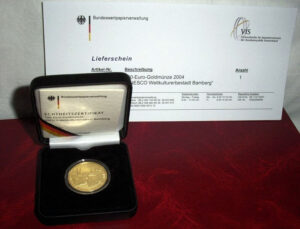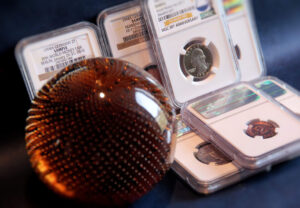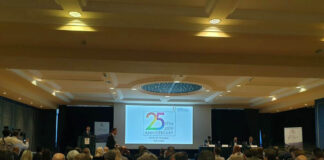Silver and gold are among those precious metals that have been popular in coinage for centuries, not least because they are highly resistant to corrosion. Both metals also have the quality of being easily malleable and are therefore very suitable for minting coins and medals. Special gold and silver baths are widely available on the market. However, whether these chemical baths are needed at all always depends on the extent to which the individual pieces are actually soiled. A basic cleaning without any special tools should be sufficient for us, as this is always the first priority. Last but not least I would like to point out once again that any cleaning attempts on historical pieces should be taboo.
Silver and Silver Alloys
Things that work perfectly with rings, necklaces and other jewellery do not necessarily have to work with coins and medals. We should always remember that, especially if we want to use another “classic”: hot water, aluminium foil and table salt.
Here too, we should know beforehand what we want to clean and why. Patina is not dirt, but a characteristic material property of silver! For me, removing a patina that has grown over the years is utter nonsense and above all unnecessary. On the contrary, a fine patina on silver coins can actually increase the collector’s value considerably. By using the above mentioned classic, the grown patina will be lost entirely. Is it worth it?
Light soiling can be tackled with a mild soap bath. Only clean one single piece at a time. Please only dab the single piece lightly with a microfibre cloth in order to avoid scratches. Always rinse well with lukewarm water and let the coin dry properly. Some collectors swear by the cleaning power of olive oil. In this case, the coin should be left in an oil bath for at least one day to soften any adhering dirt. Personally I don’t think much of it, but if you want to try it, go ahead. But always use a nearly destroyed silver coin as a “guinea pig”!

Gold and Gold Alloys
Generally, a gold piece of high alloy doesn’t need any cleaning. Gold does not oxidise and does not get a patina. However, if a piece is soiled, just put it in a mild soap solution and clean it without applying any pressure between thumb and index finger. Always remember that gold is a very soft metal and that it can be easily deformed. As quickly as gold can be deformed, it can also get scratches if handled inappropriately. Only clean one piece at a time. Then allow to dry well. If there is a gold coin in the soap bath, then other coin metals have no business in there at the same time. The different metals could react with each other.
Conclusion Basic Cleaning
If the washing day did not deliver the desired results, then it is recommended to make use of the extensive range of immersion baths available on the market. They are also available for aluminium and iron coins. However, my concern was to work with simple and non-hazardous products first. Whether to use an ultrasonic device for your cleaning experiments is also up to you. I myself have had many positive experiences with simple soap baths and just for the sake of completeness I would like to point out this additional possibility here. At least for the cleaning of my reading glasses, such devices brought good results.
Do!
- Leave a patina on silver coins because it often determines the value.
- Wear cotton gloves because like us, gold and silver coins do not love fingerprints.
- Only purchase gold and silver coins from specialised coin dealers or safe sources.
- Your coins need sufficient protection from thieves.
- If you only collect gold or silver coins, then you should definitely think about a safe storage place. A simple spot in the cupboard is no longer sufficient.
Don’t!
- Never clean historical coins, they better stay as they are!
- Do not rub the coins with a brush, this is guaranteed to leave marks!
- Keep your hands off pieces with the production method “proof” or “brilliant uncirculated”!!
- Don’t even try any polishing attempts, no matter the tool! It will only cause damage!
- Do not attempt to clean coloured coins!

New “Slabbing” Trend
“Slabbing” is not just a temporary fashion because nowadays also in Europe coins are graded by experienced companies, then put into a plastic box (slab) and sealed. This is to ensure that the precious pieces are stored in a counterfeit-proof manner for the future. As a collector you can think what you want about the whole thing. Let’s just look at the facts. Coins in such plastic boxes, i.e. “slabbed” coins, are increasingly offered in specialised shops or at coin auctions. We should not close our eyes to this, but first read more information about this new phenomenon. Of course, everyone has to decide for themselves. Personally, the first question I always ask myself is: what are the arguments for and against it?
What Speaks For and Against Slabbing
Most often, the coin edge, which is almost invisible in the slab, is mentioned as a negative argument. I agree with that. The edge of a coin is an extremely important feature in many pieces and usually provides indispensable information. For example, how would one identify the long middle line of the “E” on German coins in such a box for additional identification and verification of the mint? Due to the small brackets this is impossible.
The advantage of “slabbing” is that you can safely take slabbed pieces in your hand to look at them without leaving unwanted fingerprints on the piece. This game can now be continued forever. In the end you can either let yourself be convinced or you can continue to demonise the whole thing.
Greater Security through “Slabbing”?
But I am concerned with a completely different question: are the coins sufficiently well stored in such a slab? There is much to suggest that they are! Further questions are: Even after years of being locked up in a slab, is the coin still secure? For example, how do our coins tolerate large fluctuations in temperature? I think that from these points of view, the matter has not yet been sufficiently considered. It is high time to gain more experience in this respect.
I conducted three extreme experiments with some encapsulated coins in the slab and I want to share my observations with you. I used original slabbed coins, which are distributed by companies at fairs and exhibitions for advertising purposes. Of course this experiment does not provide an absolute guarantee for other pieces!
Slabbing Test 1: 24 Hours in Water
I put the slab with the coin in a bowl of water for 24 hours and weighted it down. Result: The slab remained waterproof and the coin showed no traces of humidity, nor did it tarnish.
Slabbing Test 2: 24 Hours in the Freezer
The slab with inserted coin was stored in the freezer for 24 hours, at minus 18 degrees Celsius. Afterwards I “defrosted” the slab in the living room at about 21 degrees Celsius.
Result: The outer plastic box began to mist up and immediately a rime-like coating developed. I removed it after five minutes to get a look at the coin. The coin was free of coating and didn’t tarnish.
Slabbing Test 3: Slab Fell Off the Table
I dropped the slab with coin from 62 cm height from the table on three different floors. From this height the slab fell onto a carpet, onto laminate and onto a tiled floor. Result: The slab survived all three falling tests undamaged. The individual coins remained in their holders.
I don’t want to add anything to this, but just raise the question: What would have happened to a precious coin lying in a conventional coin capsule or even “naked” on the table, if it had undergone the same procedure (which of course nobody would do!)? Think of it as you like, but there are always two sides to a coin.
Here you can read part 1, which covers the basics and preparations for coin care, and part 2 on the “washing day” of coins made of base metals and alloys!
You can read more about our author in the Who’s who on Reiner Graff.
You can find numerous popular articles by numiscontrol on zero euro banknotes, euro coins, the treasures in our wallets and much more in our archive.





